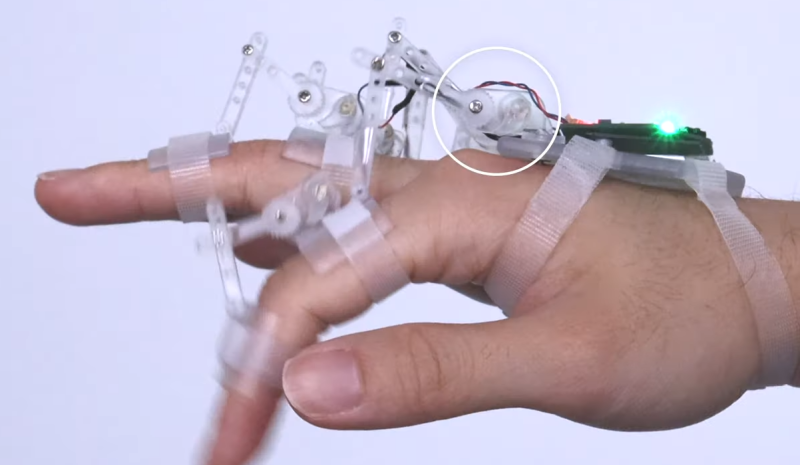Building exoskeletons for people is a rapidly growing branch of robotics. Whether it’s improving the natural abilities of humans with added strength or helping those with disabilities, the field has plenty of room for new inventions for the augmentation of humans. One of the latest comes to us from a team out of the University of Chicago who recently demonstrated a method of adding brakes to a robotic glove which gives impressive digital control (PDF warning).
The robotic glove is known as DextrEMS but doesn’t actually move the fingers itself. That is handled by a series of electrodes on the forearm which stimulate the finger muscles using Electrical Muscle Stimulation (EMS), hence the name. The problem with EMS for manipulating fingers is that the precision isn’t that great and it tends to cause oscillations. That’s where the glove comes in: each finger includes a series of ratcheting mechanisms that act as brakes which can position the fingers precisely enough to make intelligible signs in sign language or even play a guitar or piano.
For anyone interested in robotics or exoskeletons, the white paper is worth a read. Adding this level of precision to an exoskeleton that manipulates something as small as the fingers opens up a brave new world of robotics, but if you’re looking for something that operates on the scale of an entire human body, take a look at this full-size strength-multiplying exoskeleton that can help you lift superhuman amounts of weight.
















I wanted to do this for my thesis! To bad I couldn’t ffindthe materials (parts) to do it. So we had to do a radio controlled (by Wi-Fi) toy car with a camera and stuff. Proyects like this have been featured in Hackaday before like of ot were the big deal, we did it way earlier, when smartphones with Wi-Fi where just starting to be commercially available. Teacher’s where in awe haha.
Still, would’ve like to do this hand proyect. Too bad Chile is worthless when it comes to finding special parts (and for almost everything for that matter, if you pay US$10 for something, that same part would cost US$20+ if available, things have gotten cheaper. But still more expensive). You had to end up doing everything in that time. Importing in that time from digikey was US$100 even if buying a US$0.01 0.5 grams resistor. I haven’t tried buying something from digikey since then. Do not know if it’s cheaper now. Me and lots of classmates ended up working in different fields and/or studying different careers.
All this puts lots of brakes to doing stuff and doing R&D. Government and college do not invest too much money in that… Government even reduced the % of the GDP (0.38%) that was invested for this. Creating a lot of unemployment in the area, in 2018 there were more than 2000 PhD unemployed. And they keep reducing
Edit: *IF you pay US$10 in the US, we pay US$20+, for the same product (in that time, now the difference is a little less)
> Importing in that time from digikey was US$100 even if buying a US$0.01 0.5 grams resistor.
That’s what mail forwarders aka “casilleros” are for. You don’t simply pay to have a few grams FedExed to your doorstep. I’m lucky to have one that charges in 50-gram increments. There are others that hold your stuff until you tell them to repackage it all in a single box to save costs.
While the build isn’t fantastic, the concept is very interesting because this isn’t far off from total human puppetry. I do wonder if the oscillation problems stem from involuntary nuerofeedback or if it’s purely a controller issue. While morbid, it would be interesting to see how well you can control fresh corpses because nuerofeedback is a complete non-issue. If it is still and issue then It would be interesting to see if there is a point before rigor sets in that has just the right amount of resistance for smooth motion. At a certain point, you have to wonder if we can replace the spinal nerve and have computer controlled “zombies”.
Scanners live in vain.
I wrote a small piece of erotica on this subject. a prison was using ratchet suits to control their prisoners arms and legs, along with shock collars when they tampered with them. then some bondage enthusiasts bought the damaged suits to play around with.
link or it didn`t happen
never got around to finishing it so it’s only a page or two long. tell me what you think of it https://pastebin.com/2Ph39xYY
So after the fingers are in their final position are they locked by the brakes in position or are the fingers continually stimulated and just locked to damp oscillation?
I think the former, as the latter would cause a tremor for no benefit. it’s a carrot and horse arrangement, take away the carrot when you want the horse to pause.